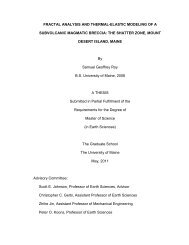Jumars, P.A. - University of Maine
Jumars, P.A. - University of Maine
Jumars, P.A. - University of Maine
You also want an ePaper? Increase the reach of your titles
YUMPU automatically turns print PDFs into web optimized ePapers that Google loves.
130 P. A . JUMARS<br />
in regard to the operation <strong>of</strong> the jaws, it may be the beginning <strong>of</strong> the<br />
divergence <strong>of</strong> maxillary morphologies in the two main branches <strong>of</strong> the<br />
following proposed phylogenetic scheme .<br />
Meiodorvillea apalpata may appear to differ from M. minuta as much as<br />
Apophryotrocha differs from Ophryotrocha. Its complete lack <strong>of</strong> palps,<br />
however, does not represent a functional dissimilarity from the palps <strong>of</strong><br />
M. minuta which are so small and so positioned that they are probably <strong>of</strong> no<br />
use in food manipulation . Both M. minuta and M. apalpata are bathyal and are<br />
found in s<strong>of</strong>t sediments .<br />
Dorvillea batia is intermediate between Dorvillea and Ophryotrocha in many<br />
respects-size, maxillary morphology, mandibular morphology, and degree <strong>of</strong><br />
development <strong>of</strong> a dorsal cirrophore . Its palps are also somewhat reduced with<br />
respect to other species <strong>of</strong> the genus Dorvillea . However, the absence <strong>of</strong><br />
neotenic characters, the presence <strong>of</strong> well-developed antennae, and, especially,<br />
the presence <strong>of</strong> notoaciculae place it in Dorvillea .<br />
Hartmann-Schroder (1971) has placed Parapodrilus Westheide, 1965, in<br />
Dorvilleidae . It may have evolved by reduction from a Parophryotrocha-like<br />
ancestor as she suggests (1971 and pers. comm .), but the present point <strong>of</strong> view<br />
is that the evidence is too scanty for the placement <strong>of</strong> Parapodrilus in<br />
Dorvilleidae . Ontogenic comparison with Ophryotrocha puerilis (Akesson,<br />
1967) and investigation <strong>of</strong> the musculature <strong>of</strong> the peristomial region <strong>of</strong><br />
Parapodrilus would be useful in this regard . Complete lack <strong>of</strong> prostomial<br />
appendages and jaws, however, indicates separate familial status might be<br />
advisable for Parapodrilus even if Ophryotrocha or Parophryotrocha contains<br />
its nearest living relative .<br />
The taxonomic value <strong>of</strong> quantitative maxillary characters must be seriously<br />
re-examined in light <strong>of</strong> present evidence . In the sample <strong>of</strong> Schistomeringos<br />
rudolphi from the Bay <strong>of</strong> Naples (AHF 10950), the number <strong>of</strong> free maxillary<br />
denticles is strongly correlated (P < 0 .05) with overall body size . In addition,<br />
doubled or partially doubled numbers <strong>of</strong> maxillary parts are found in some<br />
individuals <strong>of</strong> Dorvillea rubrovittata, S. rudolphi, Protodorvillea gaspeensis, and<br />
Ophryotrocha puerilis . These doubled sets are restricted to individuals with<br />
broken or worn teeth, and unworn teeth are always found immediately beneath<br />
their worn homologues . The unworn teeth are found within the s<strong>of</strong>t tissues <strong>of</strong><br />
the pharynx, while only the bases <strong>of</strong> the worn denticles, carriers, and basal<br />
plates are anchored in these tissues . When denticles in the lower, unworn sets<br />
are fully formed, they always exceed or equal in number the denticles <strong>of</strong> the<br />
worn rows . The simplest explanation <strong>of</strong> all these observations is that maxillae<br />
are occasionally replaced in many, if not all, the species <strong>of</strong> Dorvilleidae . It is<br />
not known whether this phenomenon extends to other Euniceoidea .<br />
Before quantitative characters are used in species discriminations, it must be<br />
shown that interspecific variability can be distinguished from intraspecific<br />
variability . Although the observed size-correlated variability is a taxonomic<br />
complication, it may prove valuable ecologically . Perhaps numbers <strong>of</strong> denticles<br />
can be used as an indication <strong>of</strong> age <strong>of</strong> the individual . It remains to be shown,<br />
however, whether replacement is a function <strong>of</strong> size, <strong>of</strong> age, <strong>of</strong> wear, or <strong>of</strong> some<br />
combination <strong>of</strong> factors . Ontogeny <strong>of</strong> the maxillary parts may well reveal a<br />
phylogeny more detailed and more accurate than the one presented here in<br />
Fig. 14 .
















